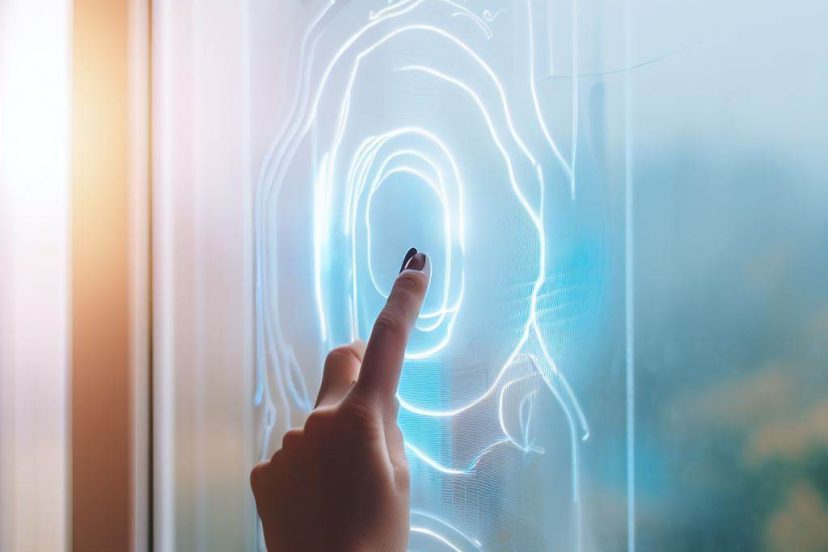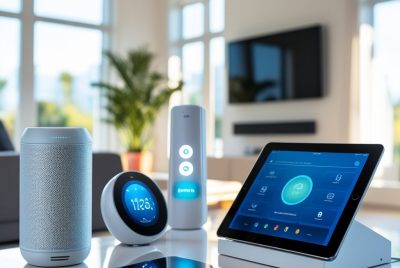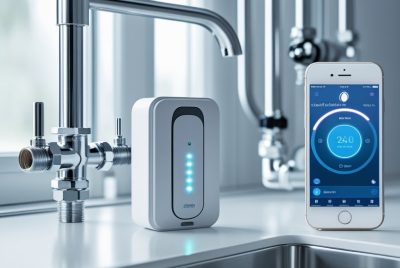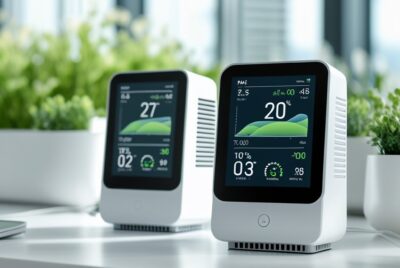Electric Smart Film for Windows – Full Guide
*We may earn a commission for purchases made using our links. Please see our disclosure to learn more.
Electric Smart Film for Windows: Revolutionizing Privacy and Energy Efficiency
Electric smart film for windows is a cutting-edge innovation in window treatments that offers both utility and modern aesthetics. I find that this technology utilizes Polymer Dispersed Liquid Crystal (PDLC) to provide privacy on demand, making it a dynamic solution for both residential and commercial spaces. At a simple flick of a switch or a press of a button, the film changes from transparent to opaque, offering an instant transition for privacy without compromising on natural light. This versatility is what leads me to think of electric smart film as a significant evolution from traditional window treatments.

I understand that one of the key appeals of electric smart film is its integration into smart home systems. With their ability to become opaque, they can replace projector screens or double as whiteboards, demonstrating their multi-functionality. I appreciate that the installation process doesn’t mandate a complete window replacement either. Instead, the film is applied directly to existing glass, making it a flexible option for upgrading windows to smart windows. Additionally, considering the energy efficiency benefits from regulating light and heat transmissions, I see that electric smart film is poised to become an essential component of eco-friendly home design.
Furthermore, as someone who values both design and functionality, I notice how modern homes and offices can harness electric smart film for aesthetic enhancements. Beyond its functional merits, the sleek design complements various interiors, seamlessly blending with minimalistic or tech-driven decor. This adaptability not only makes it practical but also a design statement that aligns well with contemporary architecture and interior preferences. Therefore, I argue that the adoption of electric smart film might just be the smartest move for those looking to fuse high-tech privacy with sophisticated design.
Technology Overview

Electric smart film technology, commonly known as switchable glass, harnesses Polymer Dispersed Liquid Crystal (PDLC) technology to provide privacy on demand. At its core, PDLC is a liquid crystal film that transitions from a frosted (opaque) state to transparent when you apply an electrical current. I understand this technology as akin to microscopic blinds that can instantly switch from open to closed.
When no current is applied to the smart film, the liquid crystals are randomly distributed, causing light to scatter and the film to appear frosted. This provides complete privacy while still allowing light to pass through. As soon as I activate the film by applying an electrical current, the liquid crystals align, and the film becomes clear, offering a fully unobstructed view.
Here’s a brief overview of the features:
- Switchable States: Frosted and Transparent
- Operation: A flick of a switch, a remote control, or even a smartphone app can adjust the opacity.
- Applications: Can be used on windows, partitions, as a projection screen, or other surfaces requiring variable opacity.
- Brands: Notable brands include Smart Tint®, Smart Film®, and Smart Cling®.
I appreciate the convenience smart film brings to modern living and working environments, allowing for quick alternation between a private, secluded space and an open, transparent one. The ability to control the level of privacy and natural lighting without physical blinds or curtains is both innovative and functional. This smart window film integrates neatly with contemporary smart home and office systems, enhancing aesthetics and comfort.
Benefits and Applications

In exploring the benefits and applications of electric smart film, I find that they significantly enhance modern living by offering convenience, privacy, and energy efficiency. These films have made their mark in both residential and commercial sectors, providing switchable privacy control and protection from harmful UV rays while contributing to environmental sustainability.
Residential Use
In the context of homes, the practicality of switchable privacy film is multifaceted. I observe its ability to transform from transparent to opaque at the click of a button provides unparalleled privacy for homeowners without compromising natural light. Such an application serves multiple purposes: from creating instant privacy for bathroom windows to acting as an impromptu projection screen for home cinemas.
- Privacy Control: Enables instant switch from clear to opaque.
- Protection: Blocks over 95% of UV rays, protecting interior furnishings.
Commercial Use
Moving on to offices and commercial spaces, the demand for smart films is attributable to their dynamic nature. The films serve as an impressive alternative to traditional window coverings for meeting rooms, providing a sleek look and instant privacy for sensitive discussions. The functionality extends to safety and security, as the film fortifies the glass against breakage.
- Energy Savings: Smart films contribute to reduced reliance on artificial lighting and air conditioning.
- Security: Reinforces glass, adding an additional layer of security to commercial premises.
Environmental Impact
I consider the impact of this technology on the environment to be substantial. By enabling natural light while minimizing heat gain or loss, smart films can lead to significant energy savings in both homes and office buildings. This energy efficiency corresponds to a lower carbon footprint, aligning with the goals of sustainable environmental practices.
- Energy Efficiency: Contributes to environmental sustainability through better insulation properties.
- Comfort: Elevates levels of comfort by maintaining consistent internal temperatures.
Installation and Operation

In this section, I’ll guide you through the correct setup process for Electric Smart Film, the functionality it delivers for your windows, and the maintenance steps necessary to ensure long-term performance. Understanding these elements is vital for optimal use and longevity of the film.
Setup Process for Your Electric Smart Film for Windows
Preparation: Before installation, it’s crucial that the glass surface is thoroughly cleaned to be free of debris, dirt, and oil. A poorly prepared surface can negatively impact adhesion and the film’s appearance.
- Measure and Cut: I recommend measuring the glass dimensions accurately. This electric smart film often comes pre-cut to fit your requirements, but if adjustments are needed, they should be done with utmost precision.
- Alignment: Starting with an initial partial installation (about 4 inches), I ensure that the film aligns perfectly with the glass edges.
- Application: It’s wise to have two people handle the film during installation to avoid creasing or damage. Installing the film typically involves peeling off the backing and carefully applying the film on the glass, starting from one edge and moving gradually to the other end.
- Connection: The film is connected to a power source. Adhering to the operating voltage specifications is critical; Smart Films generally operate on low voltage for safety and efficiency. After installation, I always ensure that the wiring is properly insulated and secured.
Functionality
Transparency Control: By applying an electric current, the smart film transitions from opaque to transparent, offering privacy or clear views according to user preference.
- Opaque: In its default, powered-off state, the film provides privacy by being opaque.
- Transparent: When electric current is applied, the film becomes transparent, allowing for clear visibility.
Controls: I find the controls for electric smart film to be user-friendly, with various options from wall switches to mobile apps which make the operation as simple as flicking a light switch or tapping a phone screen.
Maintenance and Care for Electric Smart Film for Windows
Cleaning: I regularly clean the film surface with a soft, non-abrasive cloth to maintain clarity and responsiveness. You should avoid harsh chemicals as they can damage the film.
Troubleshooting: For any issues such as uneven tinting or responsiveness problems, I consult the troubleshooting guidelines provided by the manufacturer. This includes checking for loose connections or damaged spots on the film, and taking appropriate action as recommended.
Warranty: I always keep the terms of the warranty in mind. Regular maintenance and care as prescribed by the manufacturer helps in avoiding actions that may void the warranty.
Electronic Tint Technologies

Electronic tint technologies are transforming how I manage light and privacy in modern living spaces. These innovations offer a dynamic alternative to traditional window treatments through switchable glass, smart window tint, and electronic blinds.
Smart Window Tint
Smart Window Tint, like Smart Film® and ElectraTint, represents a significant leap in electronic window tint technology. I consider these as an ideal solution for privacy on demand; they change from clear to opaque with the application of electrical current. ElectraTint boasts some of the highest clarity on the market, which makes it a top choice for enhancing the functionality of office spaces.
- Productivity: Optimizes natural light while maintaining privacy.
- Ease of Use: Adjust transparency with simple controls.
Electronic Blinds
Electronic blinds are an automated solution, providing a streamlined look that integrates seamlessly with smart home systems. The technology allows me to adjust the opacity of windows without traditional blinds or shades.
- Customization: Pre-programmable settings for different times of the day.
- Integration: Can be connected to smart home devices for central control.
Switchable Glass Alternatives
Switchable glass alternatives offer my living spaces a futuristic feel with practical benefits. Much like smart window tint, they adjust in transparency and are typically integrated directly into the glass instead of applied as a film.
- Versatility: Ideal for corporate, residential, or transportation uses.
- Installation: Available in customizable shapes and sizes for various applications.
Product Specifications and Safety

When considering Electric Smart Film for windows, it’s important to focus on the technical specifications related to voltage and energy as well as the safety and protection standards the product adheres to. My discussion will outline the key compliance factors and the protective features of this innovative technology.
Voltage and Energy Compliance
Operating Voltage: The Electric Smart Film typically operates on low voltage, usually between AC 48V to 60V, ensuring energy efficiency and safety. The low-voltage requirement reduces the risk of electrical hazards, making it a safe addition to both residential and commercial spaces.
Energy Efficiency: These smart films are designed to optimize energy consumption. By regulating the amount of light transmission, they can contribute to thermal insulation, decreasing the need for heavy reliance on heating and cooling systems.
Protection Standards
Security and Safety: Electric Smart Film’s robust nature reinforces the glass to which it is applied, providing an additional layer of protection. In its opaque state, it enhances privacy and can act as a deterrent against unauthorized observation.
UV Protection: The film blocks harmful UV rays, significantly reducing sun damage to interior furnishings and health risks associated with UV exposure.
Warranty: Manufacturer warranties commonly cover defects in materials and workmanship, providing assurance of the film’s durability and function over time.
Safety Compliance: Electric Smart Film is tested for compliance with international safety standards. My focus is on products that hold certifications confirming their safety for use in various environments, ensuring peace of mind for consumers.
In summary, Electric Smart Film not only offers convenience and aesthetic flexibility but also adheres to strict safety and energy standards, contributing to a secure and energy-efficient environment.
Purchasing Guide for Electric Smart Film for Windows
When investing in electric smart film for windows, I consider the cost implications and the credibility of the supplier. Calculating the potential energy savings and understanding the warranty are crucial to making an informed decision.
Cost Assessment of Electric Smart Film for Windows
Initial Costs: The price of electric smart film can be significant, so I start by determining my budget and the size and number of windows needing coverage.
- Energy Savings: I account for long-term financial benefits. Employing smart film can reduce energy expenses by lessening solar heat gain, which might lead to a drop in cooling costs by up to 50%.
Ongoing Costs: Maintenance expenses should be minimal, but it’s wise to factor in the potential cost of repairs or replacements over the film’s lifespan.
Warranty: I ensure the smart film comes with a robust warranty that guarantees its performance and provides security for my investment.
Provider Evaluation for Electric Smart Film for Windows
Reputation: I scrutinize reviews and testimonials to gauge the provider’s track record. Their reliability and customer service history are important for post-purchase support.
Product Quality: High-quality smart film offers comfort by allowing control over light and privacy. I look for films that shift from opaque to transparent without fault and that come with reliable controls, whether they are manual or app-based.
Installation: I assess whether the provider offers professional installation, which might add to the upfront cost but ensures optimal functionality.
Certifications: Any electric smart film I select must meet industry standards. Certifications confirm that recognized institutions validate the film’s energy efficiency and UV protection performance.
Selecting the right electric smart film is more than just a purchase; it’s an investment in my comfort and home’s energy efficiency. I take the time to do the due diligence to ensure that the product meets my needs and the supplier stands behind its product.
FAQ’s for Electric Smart Film for Windows
In this section, I’m covering the most common queries regarding electric smart film for windows, providing you with concise and accurate answers.
1. What factors influence the pricing of electric smart film for windows?
The cost of electric smart film for windows can range based on project size, complexity, and additional features like insulated glass units or customized patterns. Prices generally vary from $30 to $140 per square foot.
2. How is smart film applied to home windows, and does it differ from professional installation services?
You can install smart film on home windows with an adhesive layer or by using double-sided tape for non-adhesive options. Professional installation services might offer a more precise application and the ability to connect the film’s electrical components to home automation systems.
3. What are the benefits of using PDLC smart film over traditional window treatments?
PDLC smart film offers instant privacy with a button, serves as a projection screen, and customizes to various sizes and shapes.
4. Can you explain the technology behind switchable smart film and how it operates?
Switchable smart film operates using PDLC technology that turns opaque or clear when you apply an electrical current. The liquid crystals align when electrified, allowing light to pass through and rendering the film transparent.
What is the clarity and visibility like for smart film when it is in the opaque state?
5. When in the opaque state, smart film provides a frosted glass look that ensures privacy while still allowing light to enter the room. The film does not become completely black, maintaining a level of ambient natural lighting.




